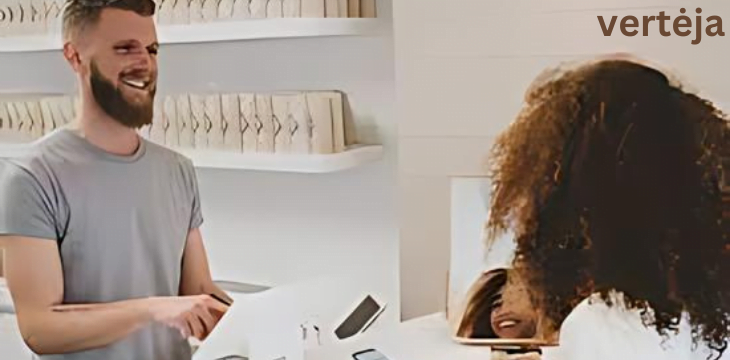Ever wondered what goes into making sure a message translates seamlessly from one language to another? It’s not just about knowing words; it’s about capturing the essence of a conversation, a document, or even a piece of literature. Enter the world of the “vertėja”—a term that might seem a bit exotic but is central to the art of translation. If you’ve ever marveled at how a book written in French ends up sounding natural in English, or how a business deal gets done despite language barriers, you’ve got a vertėja to thank!
In this article, we’ll dive into the intricate world of the vertėja, exploring what makes this role so vital, and why it’s far more than just flipping words from one language to another.
Contents
What is a Vertėja
A “vertėja” is a term for a translator, particularly in Lithuanian contexts. But don’t let the label fool you; the role encompasses much more than merely translating text. Here’s a closer look at what being a vertėja involves:
The Art of Translation
- Linguistic Mastery: A vertėja’s needs to be fluent in at least two languages, often more. It’s not just about translating words but capturing their meaning and context.
- Cultural Sensitivity: Understanding cultural nuances is crucial. The way humor, idioms, or even politeness is expressed can vary widely across cultures.
More Than Words
- Contextual Understanding: Translating isn’t about swapping words; it’s about understanding context. A vertėja must grasp the underlying message, tone, and intent.
- Technical Expertise: In specialized fields like legal or medical translation, a vertėja needs to be familiar with specific jargon and industry practices.
The Journey of a Vertėja
Let’s take a closer look at the day-to-day journey of a vertėja. It’s a path filled with challenges, rewards, and a lot of linguistic gymnastics!
Training and Skills
- Educational Background: Most vertėjas have degrees in translation, linguistics, or a related field. Specialized training in their chosen languages is often required.
- Continuous Learning: Language evolves, and so does translation. A vertėja must stay updated with new terms, cultural shifts, and technological advances.
Tools of the Trade
- Translation Software: Modern translators often use CAT (Computer-Assisted Translation) tools to help manage large projects and maintain consistency.
- Research Skills: A vertėja often needs to dig into various sources to ensure accuracy, especially when dealing with less common languages or specialized subjects.
The Challenges Faced by a Vertėja
Being a vertėja isn’t all smooth sailing. Here are some common hurdles:
- Idioms and Expressions: What’s a common saying in one language might make no sense in another. A vertėja must find ways to convey these ideas accurately.
- Social Context: Translating content in a way that respects and reflects social norms and expectations can be tricky.
Maintaining Accuracy
- Contextual Consistency: Ensuring that the translation maintains the same tone and intent as the original can be challenging.
- Overcoming Language Gaps: Sometimes, there’s simply no direct translation for a concept. In these cases, a vertėja needs to be creative and resourceful.
The Impact of a Vertėja on Global Communication
A vertėja plays a pivotal role in making the world a smaller place. Here’s how:
Bridging Cultural Gaps
- Facilitating International Business: Clear communication is key in global markets. A vertėja ensures that business negotiations, contracts, and marketing materials are accurately translated.
- Promoting Cultural Exchange: Translators help spread literature, art, and media across borders, fostering greater understanding and appreciation of different cultures.
Enhancing Accessibility
- Breaking Down Barriers: By translating essential documents and information, vertėjas make services and resources accessible to non-native speakers.
- Supporting Education: Educational materials and research can reach a wider audience thanks to effective translation.
FAQs About Vertėjas
Q: What qualifications does a vertėja need?
A: Most vertėjas have a degree in translation or a related field, along with proficiency in multiple languages. Specialization in certain areas can also be beneficial.
Q: How do vertėjas handle idiomatic expressions?
A: A vertėja uses their understanding of both languages and cultures to find equivalent expressions or to convey the meaning in a way that makes sense in the target language.
Q: What tools do vertėjas use?
A: They often use translation software, dictionaries, and research tools to aid in their work, ensuring accuracy and consistency.
Q: Can a vertėja work in multiple fields?
A: Absolutely! Many vertėjas specialize in specific areas like legal, medical, or literary translation, but they can also work across various fields depending on their expertise.
Q: How important is cultural knowledge in translation?
A: Extremely important. Understanding cultural nuances is key to delivering a translation that is not only accurate but also appropriate for the target audience.
Conclusion
So there you have it—a glimpse into the fascinating world of the vertėja. This role is far more than just converting words from one language to another. It’s about understanding, interpreting, and bridging gaps between cultures and people. Whether it’s for business, literature, or everyday communication, the work of a vertėja is indispensable in our increasingly globalized world
